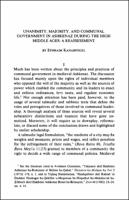Please use this identifier to cite or link to this item:
https://hdl.handle.net/20.500.12202/8558| Title: | Unanimity, Majority, and Communal Government in Ashkenaz During the High Middle Ages: A Reassessment |
| Authors: | Kanarfogel, Ephraim 0000-0002-7539-7802 |
| Keywords: | Jewish communal government High Middle Ages Medieval Ashkenaz Tosafist period role of scholars |
| Issue Date: | 1992 |
| Publisher: | New York: American Academy for Jewish Research |
| Citation: | Kanarfogel, E. (1992). Unanimity, Majority, and Communal Government in Ashkenaz During the High Middle Ages: A Reassessment. Proceedings - American Academy for Jewish Research, 58, 79-106. |
| Series/Report no.: | Proceedings - American Academy for Jewish Research.; ;58 |
| Abstract: | What emerges from our study of communal government in medieval Ashkenaz is that during the twelfth and thirteenth centuries, discussions concerning adam }Jashuv, the power of the majority, and the prerogatives and functions of the tuvei ha- 'ir remained in a state of flux. Throughout the Tosafist period, members of the community and their duly appointed boards retained much power. While temporal conditions and conceptions undoubtedly had an impact, 60 leading Ashkenazic halakhists formulated their positions on issues of communal government based primarily on their analyses of relevant talmudic sources. The role of scholars in communal government was defined by the parameters of talmudic law, which were open to varied and diverse interpretations. (from Conclusion). |
| Description: | Scholarly article |
| URI: | https://hdl.handle.net/20.500.12202/8558 |
| ISSN: | 0065-6798 |
| Appears in Collections: | Bernard Revel Graduate School of Jewish Studies (BRGS): Faculty Publications |
Files in This Item:
| File | Description | Size | Format | |
|---|---|---|---|---|
| Ephraim_Kanarfogel_Unanimity_Majority_79-106.pdf | 2.31 MB | Adobe PDF |  View/Open |
This item is licensed under a Creative Commons License

